- Home
- Personality
- How Small Dogs Sleep
How Small Dogs Sleep – Everything You Want and Need to Know
How Small Dogs Sleep by Vicki Smirnova |Published 02-15-2021
Dogs are lovable and loyal creatures. Pet owners usually ask various questions. What are their different sleeping patterns/behaviors? How long does a dog sleep in a day? And many more questions related to the quality of their pet’s sleep patterns.
Here, we will discuss dog naps and all related facts in the light of scientific literature.
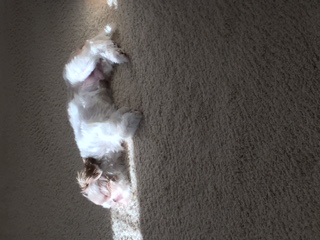
Do Dogs Sleep?
We all assume our dogs sleep but do they? It has been scientifically proven that small pets nap just like human beings. Interestingly, dogs sleep even more than humans do.
On average, a pet sleeps 12 to 14 hours per day, but the amount of time is based on breed, age, gender, and other parameters. However, it has been observed that puppies - who expend a lot of energy learning different things - may sleep up to 20 hours. Older dogs also tend to rest more.
The total amount of sleep a Shih Tzu usually gets depends on its age. A Shih Tzu puppy sleeps for about 14 hours a day. An adult pet will probably rest 12 hours a day, and an older pet of this breed sleeps over 20 hours.
According to a research study, dogs spend 50% of their day sleeping, 30% lounging, and 20% active—additionally, pets nap when they are bored and have nothing to do. Generally, police pets or farm pets who have to do much work do not nap a lot.
Sleeping Positions
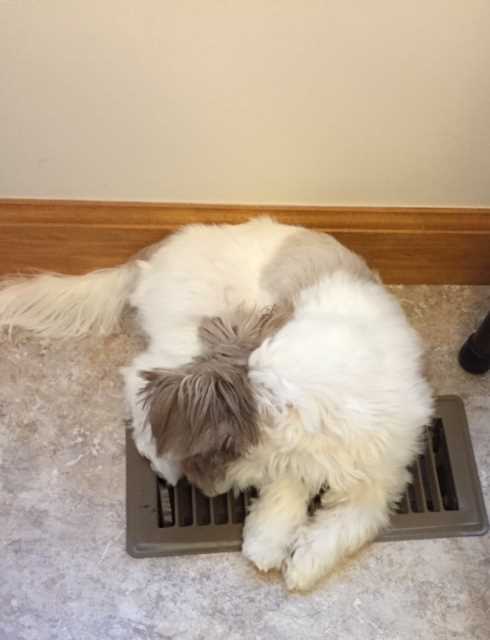
Pets nap in various positions, such as on the side, curled up, etc. Surprisingly, the different sleeping habits of dogs also provide an idea of their health and mood. It is up to the pet owner to pay attention to the sleeping position of the pet. According to Casper, sudden changes in sleeping position can be an alarm that your pet is not feeling well (or any other medical issue). If you observe any change in your pet’s sleeping pattern/behavior, talk to your vet.
Common sleeping positions
- On their side: This is an easy and comfortable sleeping position.
- Superman position: This position is typical for puppies, but some breeds continue to nap in this position into adulthood. You'll recognize this as the dog with outstretched front and back legs.
- Snuggled the paws to the muzzle: A very comfortable sleeping position. Dogs sleeping in this way feel safe and secure.
- Curled up: Dogs feel comfortable while sleeping in this position, especially in the winter season.
- On the back: This sleeping position has been observed in pets, especially in the summer season. They feel comfortable while sleeping this way and secure in their environment.
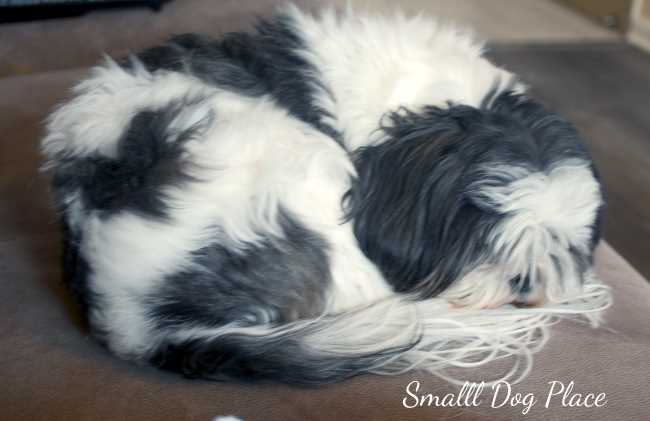
Common sleeping behaviors
- Circling and digging: It is usual for pets to circle the sleeping area several times and “dig” before lying down.
- Twitching/wagging/soft-bark: Soft-barks, grunts, tail wagging, and twitching are normal dog behaviors before napping. Usually, but excessive movements during naps are only found in puppies and senior pets. Another reason for twitching is cold weather. Generally, dogs twitch to warm themselves during cold weather.
What are common sleeping disorders in dogs?
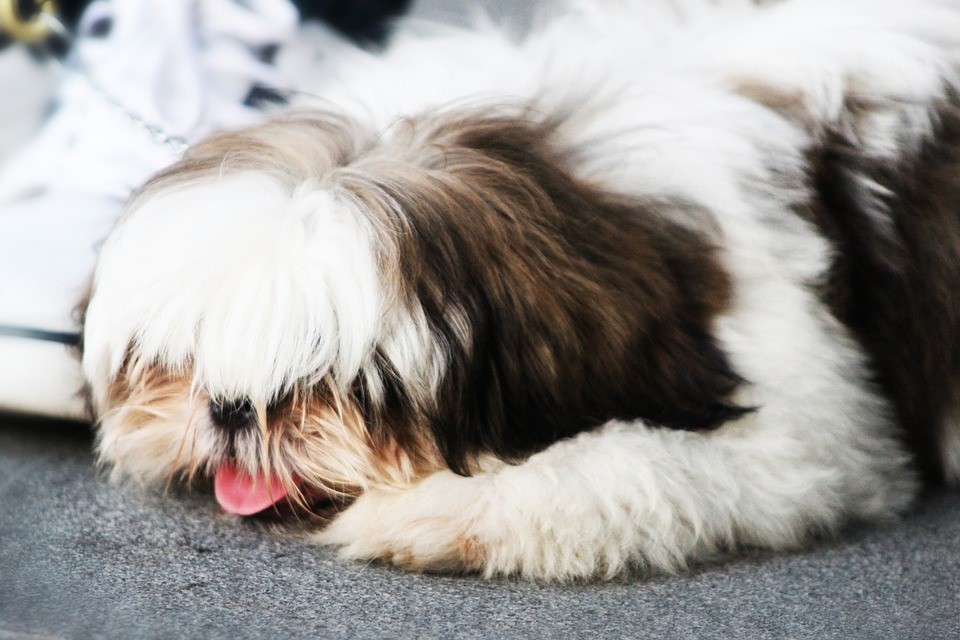
As discussed earlier, sleeping tendencies depend upon age, health status, breed, and other essential parameters. The health status of a pet is the most important of all.
For example, Shih Tzu dogs can snore. They are brachycephalic dogs and have short noses, so they are vulnerable to breathing problems.
If you notice snoring in the Shih Tzu, this is a common sign of upper airway obstruction. Many brachycephalic pets are also prone to nap apnea, a nap disorder characterized by temporary stops in breathing.
An overweight Shih Tzu tends to nap a lot more than a healthy dog. Similarly, excessive snoozing can also be an indicator of some health-related problems. For instance, separation anxiety and stress cause excessive snoozing in pets during the daytime. It is the owner’s sole responsibility to keep an eye on his/her beloved canine’s sleeping hours. Any form of excessive sleep can be a sign of potential health problems.
Narcolepsy
This sleeping disorder is characterized by excessive sleepiness. Dogs suffering from this condition usually nap during playtime. The primary reason for this sleeping trouble is a decrease in the brain chemical hypocretin, which regulates sleep.
However, this reduction in the hypocretin hormone occurs due to autoimmune diseases. In this case, the body’s immune cells attack the brain cells involved in the synthesis of hypocretin hormone.
Key signs
The essential key signs of this nervous disorder in pets are:
- Cataplexy (or sudden muscle weakness)
- Hallucinations
- Excessive daytime sleepiness
- Nap paralysis
* Narcoleptic episodes involve a sudden loss of movement and collapse. Note, this condition is usually seen in young dogs. If you suspect this particular condition in your pet, talk to your vet and get his/her suggestions.
REM behavior disorder
This is usually observed in active dogs. Weak twitching of the limbs in a dream is a normal phenomenon. Still, intense, jerky movements of the paws can signal serious violations of the central nervous system. You can talk to your vet and get medications that can decrease the physical movements during a nap.
Insomnia
Insomnia is an inability to sleep. Just like humans, pets can have insomnia. Various factors cause insomnia in pets; for instance, anxiety, pain (due to any injury or arthritis), parasitic infestation (constant irritating itching due to fleas or other ectoparasites) are significant reasons for sleeplessness in pets. It is best to consult a veterinarian and get medications to deal with this condition.
Sleep apnea
This is another serious sleeping disorder that is commonly seen in dogs. This condition causes abruptions/disturbances in the standard sleeping patterns. Dogs suffering from this disorder become annoyed and tired. Additionally, nap apnea has usually been seen in obese/overweight and brachycephalic breeds, such as English bulldogs and pugs.
Remember, if your dog is suffering from any of the above nap disorders, consult a pet expert. Better nap enhances the functioning of the dog’s immune system. Conversely, lack of a nap weakens your canine friend’s immune system.
Tips to improve dog’s sleep
- Let your pet do more exercise
- Take care of the nutrition of your dog. A well-fed pet sleeps better. Note - don’t over or underfeed your pet.
- Provide a comfortable sleeping area/bed for your dog.
- Don’t forget to visit a registered veterinarian regularly.
If you want your Shih Tzu to have a restful and healthy nap, follow these guidelines.
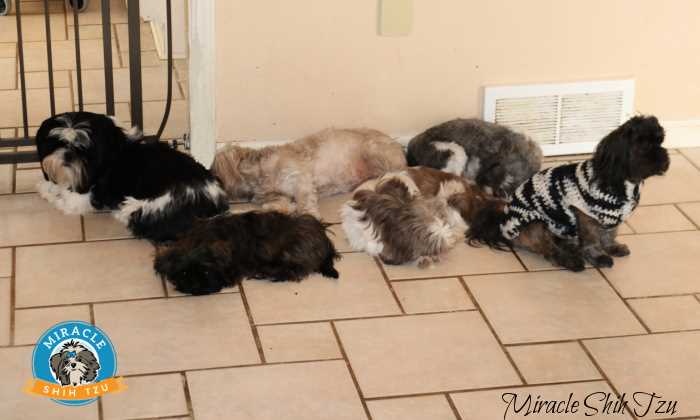
According to ThePets guide, start by taking your pet for a walk outside after dinner. Additional physical activity is great for small dogs’ nap quality.
Check your pet regularly with a veterinarian to make sure his or her problems are not health-related.
If a Shih Tzu has nap apnea, it is a serious problem and should be treated. Note that insomnia is especially common in older dogs.
Arrange a comfortable sleeping place for the Shih Tzu. Small pets need a sleeping area that promotes proper rest. If possible, set up a bed that meets these criteria:
Dogs appreciate sleeping in corners because they feel more protected there.
Lack of drafts and correct temperature. For a comfortable nap, the pet’s sleeping place should be indoors, where the temperature is approximately 75 degrees Fahrenheit.
How Long Do Dogs Sleep
Here is a quick overview of sleeping hours of different dogs based on their age and breed:
- Puppies 18-20 hours
- Adult dogs 12-14 (larger breeds can nap up to 18 hours)
- Senior dogs 12-14 hours
How Small Dogs Sleep FAQs
Is it normal for my dog to nap a lot during the daytime?
This depends upon the age, breed, health status, and physical activity of the particular dog. If you observe excessive snoozing and sleepiness in your dog during the daytime, talk to your vet.
Do puppies nap more compared to adult dogs?
Yes, puppies nap more. They usually nap for approximately 18-20 hours a day.
Does nutrition play an essential role in the sleeping pattern of a dog?
Yes, high-quality nutrition is vital and guarantees better sleep in dogs. Ensure your dog is receiving proper nutrition.
Can insomnia occur in dogs?
Yes, sleeping inability is also found in dogs. This makes them annoyed and frustrated. Various factors are responsible for this condition, such as separation anxiety, stress, and other health-associated disorders. Consult a registered veterinarian.
Do service and guard dogs nap more?
No, service and police dogs don’t nap more. They spend most of the time awake.
Do dogs dream like humans?
According to a Hungary research study, dogs dream just like humans, and they even learn while sleeping.
How Small Dogs Sleep Author Bio
Vicki Smirnova is a professional writer and editor. She has extensive experience in media, editing, translation, and audience engagement. With the advent of ThePets, Vicki began creating informational articles that help pet owners live in harmony with their pets. Vicki also enjoys spending time with her family and taking care of her cat, Brenda.
"Hi, I'm Janice Jones, a former veterinary technician and Shih Tzu expert with over 40 years of experience with the breed. Through Miracle Shih Tzu, I combine my medical background and extensive breed knowledge to provide reliable, practical advice for Shih Tzu owners. My mission is to help you give your Shih Tzu the happiest, healthiest life possible through evidence-based information and real-world solutions. Whether you're new to the breed or a seasoned owner, you'll find trusted guidance here for all aspects of Shih Tzu care.
I hold an undergraduate degree in Psychology with a minor in biology, Early Childhood Education, and Nursing, and a Master's in Mental Health Counseling.









